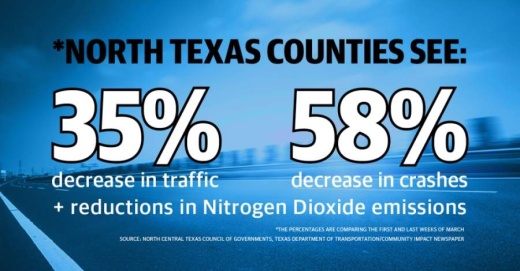The implications are far-reaching: Toll revenues are down, and public transit is servicing fewer passengers, while regional air pollutants are showing signs of decreasing, according to data provided by the North Texas Council of Governments Regional Transportation Council.
The transportation council convened May 14 to review travel behavior amid the COVID-19 pandemic.
Dallas County saw a 33% reduction in traffic volume when comparing the first and last weeks of March, according to data provided by NCTCOG. Denton County saw a 40% reduction, Tarrant County saw a 37% reduction and Collin County saw a 37% reduction.
NCTCOG Director of Transportation Michael Morris said the period of lower traffic counts should be utilized to double down on road infrastructure work, a move he said should jump-start the economy.
"There's an opportunity using innovative approaches ... to build transportation projects faster in order to create the economic benefit,” Morris said at the May 14 meeting.
One NCTCOG measure of the effects of COVID-19 on travel will analyze other possible benefits of the downtime.
“What is the impact on our ozone? Is it going to be better than what we ordinarily would have anticipated?” Morris asked. "Are fatalities higher or lower in this particular situation?”
Fort Worth City Council Member Ann Zadeh said she was in support of learning from some unexpected benefits of the pandemic on regional transportation.
“It's really important for us to take a look at the positive things that have come out of this and try to figure out a way to not just go back to the normal where our air quality was continuing to not be within attainment,” said Zadeh, who also serves on the Regional Transportation Council. “I hope that the collection of this data can help us look at our policies and procedures and see if there are ways that we can encourage behaviors that allow us to make some impact."
See some of the regional transportation trends provided by NCTCOG below.






